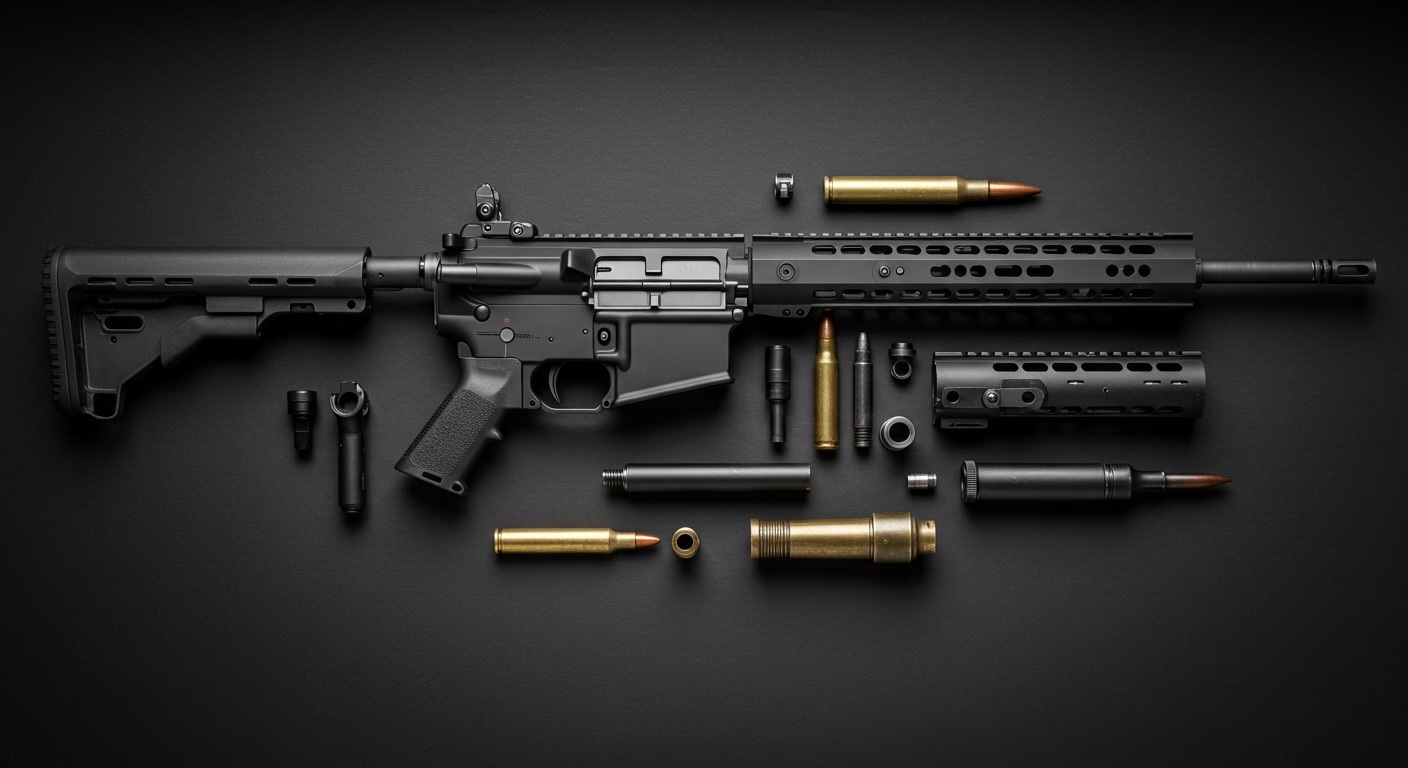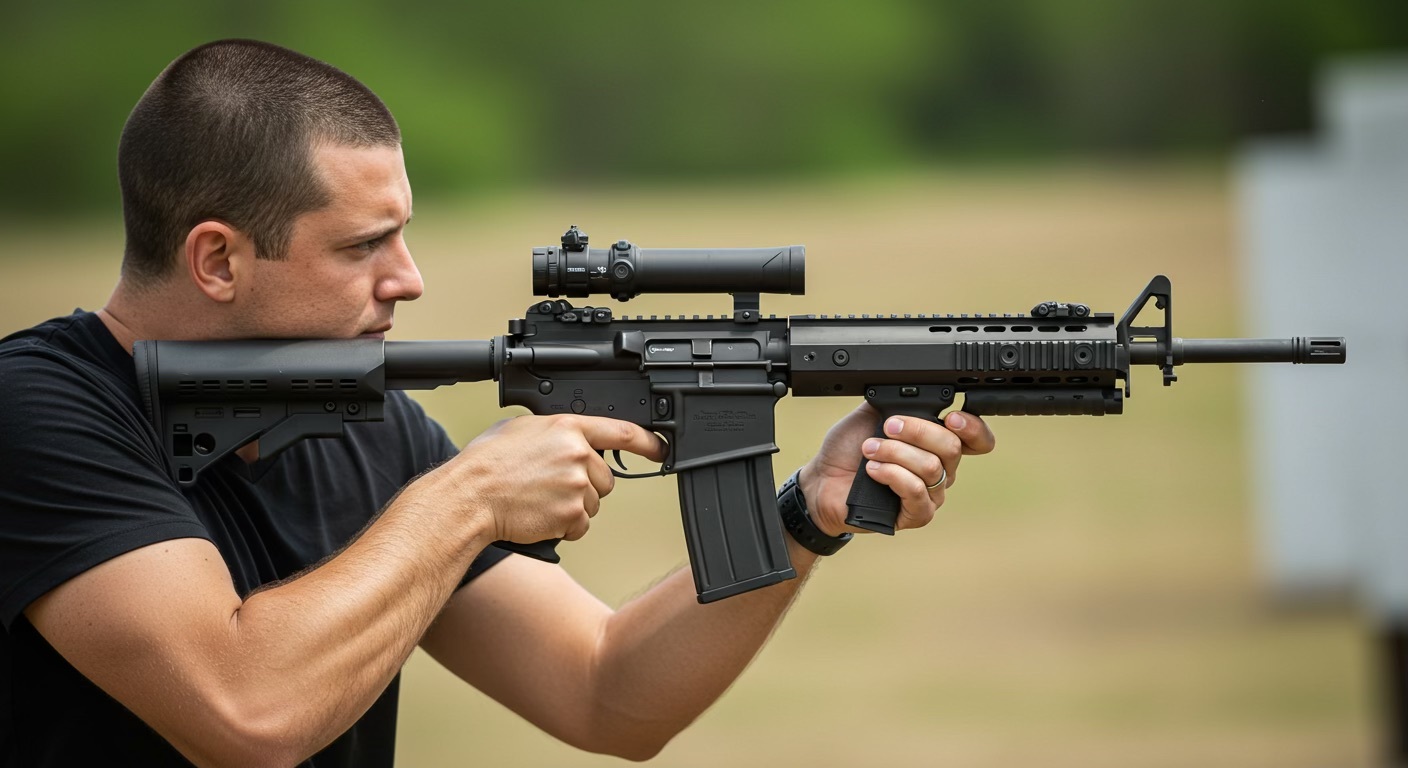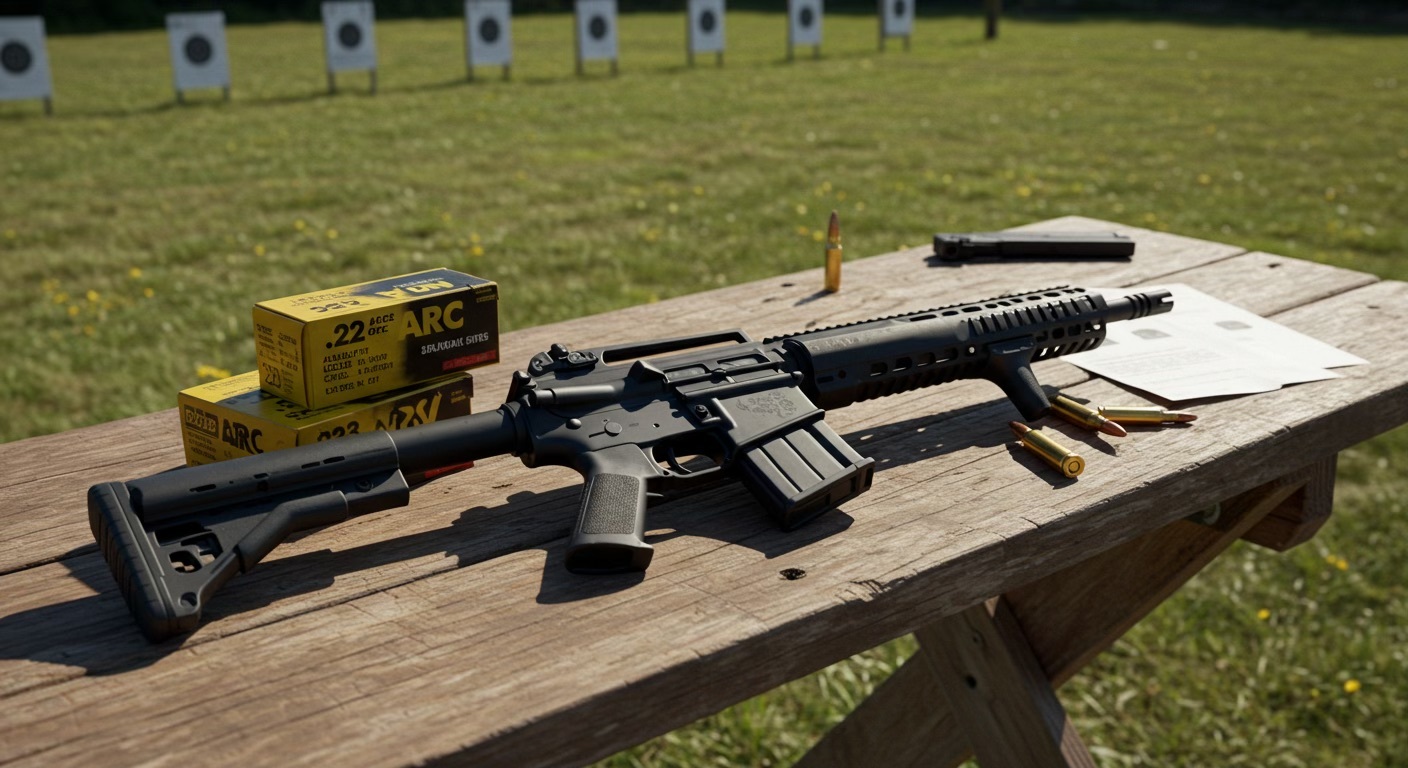Choosing the right ammunition for your rifle can significantly impact your shooting experience, whether you're hunting, target shooting, or preparing for tactical scenarios. When it comes to AR platform rifles, two popular calibers often come up in conversation: the 22 ARC and 223 Remington.
While they may sound similar and both function in AR-15 style rifles, these calibers have distinct characteristics that make each suitable for different applications. Understanding these differences is crucial for making an informed decision that matches your specific needs and shooting goals.
This comprehensive guide breaks down the essential distinctions between these two popular cartridges, helping you determine which option might be the better fit for your next rifle build or purchase from AR15 Parts.
How 22 ARC and 223 Were Designed for Different Shooting Roles
The origins of these two cartridges tell us much about their intended purposes and capabilities. The 223 Remington was developed in the late 1950s by Remington Arms and was later adopted by the U.S. military as the 5.56×45mm NATO cartridge.
It was designed as a lightweight, high-velocity round that could deliver adequate stopping power while allowing soldiers to carry more ammunition due to its lighter weight compared to the 7.62×51mm NATO round it partially replaced.
The 22 ARC (Advanced Rifle Cartridge) is a much newer development, created to bridge performance gaps between the 223 Remington and larger calibers. Its design aims to deliver enhanced long-range performance while still functioning in AR-15 platforms with minimal modifications.
The 22 ARC represents the ongoing evolution of AR platform cartridges, offering shooters increased versatility without requiring a completely different rifle system. Both cartridges continue to serve important roles in the shooting community, with the 223 Remington remaining one of the most popular calibers in America while the 22 ARC gains traction among those seeking improved ballistic performance.
Comparing 22 ARC and 223 for Range, Accuracy, and Energy
When comparing 22 ARC versus 223 ballistics, several key differences emerge that impact their practical applications.
The 223 Remington typically fires bullets weighing between 40 and 77 grains at velocities of 2,700-3,300 feet per second (fps) from a 20-inch barrel. This gives the round excellent performance at close to medium ranges, with effective accuracy commonly extending to around 300-400 yards for most shooters.
The 22 ARC, by comparison, usually accommodates heavier bullets in the 70-90 grain range and maintains higher velocities at extended distances. This translates to better retained energy downrange, improved wind resistance, and enhanced terminal performance at longer distances.
The 22 ARC typically maintains supersonic flight to distances beyond 1,000 yards in optimal conditions, making it significantly more capable at extended ranges. The ballistic coefficient (BC) of 22 ARC bullets is generally higher than comparable 223 ammunition, meaning they resist wind deflection better and maintain more predictable trajectories at distance.
For hunters and long-range target shooters, this can make a substantial difference in hit probability beyond 400 yards.
What You Need to Know About Compatibility and Components

Understanding the physical differences between these cartridges is essential for determining compatibility with your existing firearms or planning a new build.
The 223 Remington cartridge has a case length of 1.760 inches and an overall length of 2.260 inches. Its case capacity allows for appropriate powder charges to propel lighter bullets at high velocities. The 223 works in AR-15 platforms with standard bolts and magazines.
The 22 ARC features different case dimensions, requiring specific components for proper functioning. Most notably, rifles chambered for 22 ARC typically need:
- A barrel specifically chambered for 22 ARC
- An appropriate bolt face to accommodate the cartridge
- Magazines that properly feed the cartridge
For those interested in the 22 ARC platform, specialized components like the 18" 6MM ARC Barrel - Ballistic Adv - SPR provide the necessary foundation for building a rifle in this caliber. Alternatively, complete upper assemblies like the 18" 6MM ARC Complete Upper - Satern Medium SS offer a ready-to-use solution that can be attached to a standard AR-15 lower receiver.
It's worth noting that converting between these calibers isn't simply a matter of swapping barrels - proper functioning requires appropriate components specifically designed for the intended cartridge.
Which Cartridge Fits Your Real-World Shooting Scenarios?
The distinct characteristics of these cartridges make each better suited for specific applications and scenarios.
The 223 Remington excels in several areas:
- Close to medium range target shooting (0-400 yards)
- Varmint hunting and pest control
- Home defense and tactical applications
- Training and plinking due to lower ammunition cost
- Competition shooting in certain divisions
The 22 ARC demonstrates advantages in:
- Medium to long-range precision shooting (400+ yards)
- Hunting medium-sized game at extended distances
- Competitions requiring better long-range ballistics
- Situations where wind resistance and energy retention matter
- Applications benefiting from flatter trajectories
For most recreational shooters focusing on ranges under 300 yards, the 223 Remington offers more than adequate performance with the benefits of lower cost and greater ammunition availability. However, those regularly shooting beyond 400 yards or hunting at extended distances may find the ballistic advantages of the 22 ARC worth the additional investment and potentially more limited ammunition options.
Ammo Cost and Supply: What to Expect with 223 vs 22 ARC
Practical considerations regarding ammunition supply and expense often play a decisive role when choosing between cartridges.
The 223 Remington has been in widespread use for decades, resulting in:
- Extensive commercial ammunition options from nearly all major manufacturers
- A wide variety of bullet weights and designs for different applications
- Generally lower cost per round ($0.40-$1.50 depending on quality)
- Readily available components for reloaders
- Consistent availability even during ammunition shortages
The 22 ARC, being a newer and more specialized cartridge, typically presents:
- Fewer manufacturers are producing factory ammunition
- More limited selection of bullet weights and styles
- Higher cost per round ($1.00-$2.50+ depending on quality)
- Less commonly stocked at local retailers
- Sometimes affected more severely during supply chain disruptions
For high-volume shooters or those on tighter budgets, the 223 Remington's economic advantages can be substantial over time. However, for those who shoot less frequently but demand superior long-range performance, the additional cost of 22 ARC ammunition may be justified by its enhanced capabilities.
How Recoil and Comfort Compare Between 22 ARC and 223

The shooter's experience with each cartridge can significantly influence which is the better choice for individual needs.
The 223 Remington produces minimal recoil energy, typically generating between 3-4 ft-lbs in a standard AR-15 platform. This low recoil profile makes it:
- Excellent for newer shooters
- Ideal for rapid follow-up shots
- Less fatiguing during extended range sessions
- Better for teaching proper fundamentals without developing a flinch
- Suitable for smaller-framed shooters
The 22 ARC generates moderately more recoil, though still considerably less than larger calibers like .308 Winchester. This increased recoil:
- Remains manageable for most shooters
- May require slightly more practice for quick follow-up shots
- It can be effectively mitigated with proper muzzle devices
- Provides better feedback for those developing long-range skills
- Still qualifies as a relatively low-recoil option in the spectrum of rifle cartridges
For most shooters, either cartridge remains comfortable to shoot, though high-volume shooters and those particularly sensitive to recoil may prefer the softer-shooting 223 Remington.
Longevity and Upkeep: Which Cartridge Is Easier on Your Rifle?
An often overlooked but important factor in caliber selection is the impact on barrel life and maintenance requirements.
The 223 Remington typically delivers:
- Excellent barrel life (often 8,000-10,000 rounds or more before significant accuracy degradation)
- Less throat erosion due to lower pressures and temperatures
- More forgiving of less rigorous cleaning schedules
- Lower cost of barrel replacement when eventually needed
The 22 ARC generally results in:
- Shorter barrel life (typically 3,000-6,000 rounds before precision declines)
- Faster throat erosion due to higher pressures and velocities
- More benefits from careful cleaning practices
- Higher replacement costs for specialized barrels
For casual shooters who may fire only a few hundred rounds per year, these differences have minimal practical impact. However, competitive shooters or those who train extensively should factor this consideration into their overall cost analysis when selecting between these cartridges.
When browsing for components at AR15 Parts, consider these maintenance factors alongside performance characteristics to make a fully informed decision that accounts for the long-term implications of your caliber choice.
Frequently Asked Questions
Can I shoot 22 ARC in a rifle chambered for 223 Remington?
No, you cannot shoot 22 ARC ammunition in a rifle chambered for 223 Remington. The cartridges have different case dimensions and pressure ratings. Attempting to chamber and fire the wrong ammunition in your rifle can lead to catastrophic failure, potentially causing serious injury or damage to the firearm. Always ensure you're using ammunition specifically designed for your rifle's chamber.
Which caliber is better for deer hunting, 22 ARC or 223?
The 22 ARC is generally better suited for deer hunting than the 223 Remington, particularly at longer ranges. The 22 ARC can accommodate heavier bullets with better ballistic coefficients, resulting in more energy delivered to the target at distance and improved terminal performance.
However, hunters should check local regulations, as many states have minimum caliber requirements for deer hunting, and some do not permit the use of either cartridge for this purpose.
How much does barrel length affect the performance of these cartridges?
Barrel length significantly affects the performance of both cartridges. With the 223 Remington, each inch of barrel beyond 16 inches typically adds about 25-50 fps of velocity. The 22 ARC experiences similar velocity gains with increased barrel length.
For optimal long-range performance with the 22 ARC, barrels of 18-20 inches are often recommended to maximize velocity potential. Shorter barrels sacrifice velocity and effective range but offer improved handling in confined spaces.
What modifications are needed to convert an AR-15 from 223 to 22 ARC?
Converting an AR-15 from 223 to 22 ARC requires several components: a barrel chambered specifically for 22 ARC, a compatible bolt, and possibly magazines designed to reliably feed the 22 ARC cartridge. The lower receiver and other components typically remain the same.
This conversion is most easily accomplished by installing a complete 22 ARC upper receiver assembly onto an existing AR-15 lower receiver, rather than attempting to modify individual components.
Is the 22 ARC worth the additional cost over the 223 Remington?
Whether the 22 ARC is worth the additional cost depends entirely on your intended use. For shooters regularly engaging targets beyond 400 yards, hunters seeking better terminal performance at distance, or competitors needing superior wind resistance, the 22 ARC's ballistic advantages may justify the higher cost.
However, for general range use, plinking, or shooting primarily within 300 yards, the 223 Remington offers excellent performance at a lower price point with greater ammunition availability.
Final Verdict: Should You Choose 22 ARC or 223 for Your AR-15?

When comparing the 22 ARC vs 223, there's no universal "better" choice; each excels in different scenarios. The 223 Remington remains an excellent option for most shooters with its combination of low recoil, affordable ammunition, and adequate performance at common shooting distances.
Meanwhile, the 22 ARC offers compelling advantages for those pushing the limits of range, accuracy, and terminal performance. Your decision should align with your specific shooting requirements, budget constraints, and long-term goals.
Whatever your choice, quality components from reputable suppliers ensure you'll get the most from either cartridge. Consider exploring the specialized AR-15 components available through specialized retailers to build a rifle system optimized for your chosen caliber.
Contact AR15 Parts for the Right Build in 22 ARC or 223
At AR15 Parts, we help shooters build confidently with proven components for both 22 ARC and 223 Remington. Whether you're upgrading an existing rifle or starting a new build from scratch, we offer premium barrels, bolts, and complete uppers that deliver reliability and performance.
Have questions about compatibility or which caliber best fits your shooting goals? Reach out to AR15 Parts today and let our team help you build a rifle that hits your mark.

